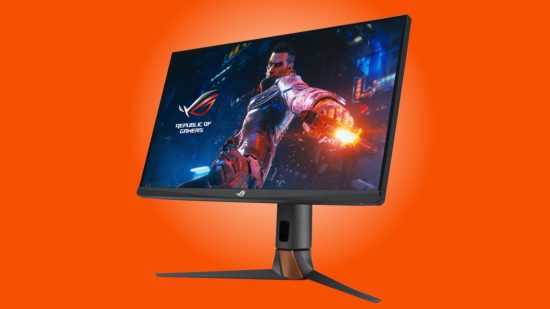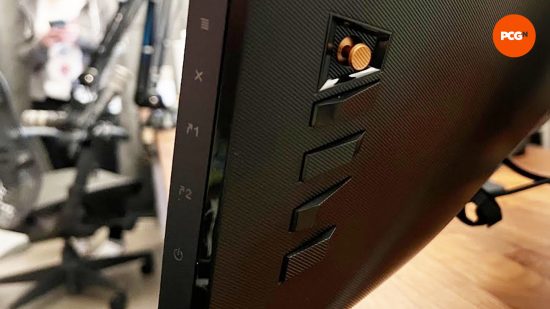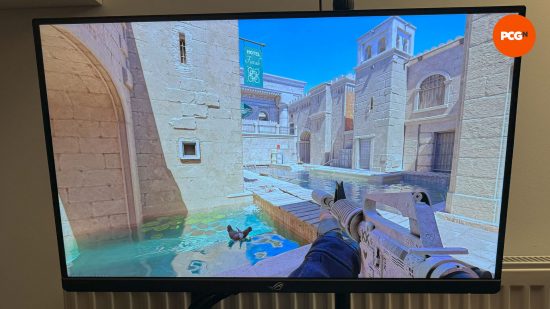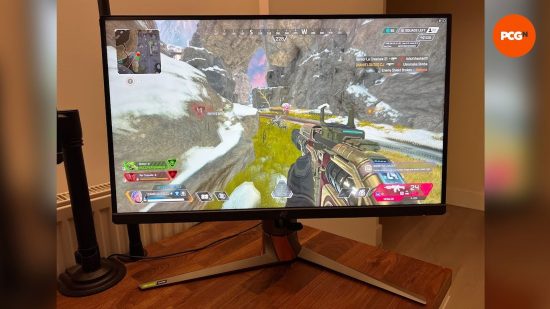Our Verdict
Up until now, the best gaming displays for esports have always featured some sort of compromise, whether it be resolution or display lag. The Asus ROG Swift 360Hz PG27AQN shows us what the next few years of esports could look like, finally allowing competitive players to enjoy the best of both worlds without having to make any sacrifices.
- ULMB 2 is a game changer
- Built-in Nvidia Reflex Analyzer
- Great SDR brightness
- Expensive
- No USB-C DP Alt. port
- Not a huge upgrade for existing 240Hz owners
After weeks of extensive testing, we’re ready to share our final verdict in our Asus PG27AQN review. 24-inch 1080p displays with 240Hz refresh rates have been the standard in most esports for years now, but the Asus PG27AQN is threatening to change that. Coming in at $1,049.00 / £1,098.98, it’s not one for the budget gamer, but if you’re after one of the best gaming monitors, you’d be hard-pressed to find a competitor.
The PG27AQN is both larger and faster than its predecessors with a 27-inch 1440p 360Hz IPS display, and now it comes with a game-changing feature: Nvidia G-Sync ULMB 2. Ultra Low Motion Blur 2 promises to deliver “over 1,000Hz of effective motion clarity”, which boils down to a smooth, tear-free image without sacrificing brightness this time around.
Why you can trust our advice ✔ At PCGamesN, our experts spend hours testing hardware and reviewing games and VPNs. We share honest, unbiased opinions to help you buy the best. Find out how we test.
ROG Swift 360Hz PG27AQN design
If you’ve seen an Asus ROG monitor over the past five years, this display’s design shouldn’t come as a shock to anyone. The PG27AQN sports ultra-thin bezels along the sides, with a surprisingly thick chin featuring the ROG branding front and center. Asus sticks with its staple ROG design for the rear paneling with a large RGB logo and circuitry-style finish. You’ll also find four buttons and a mini stick to adjust the monitor’s settings around the back.
In the box, you’ll also find Asus’ familiar tripod stand, although this time it only extends by 100mm. This gives the monitor a true ‘esports feel’—where the prime angle requires you to almost lean over the monitor, tilting it upwards towards your face—but it’s not necessarily for the better. If you plan to position this like a regular monitor, the stand leaves very little room for your keyboard and mouse. Fortunately, the monitor comes equipped with a 100mm x 100mm VESA mount, giving you the option to place the display on a monitor arm for better ergonomics.
Asus is trying to make a bold statement with this monitor: esports gamers can finally move on from their old displays. Yet the design of the PG27AQN doesn’t reflect that at all. Again, this design has been used for years, and it’s starting to show its age compared to recently released monitors like Dough’s Spectrum One and Dell’s UltraSharp U2723QE. Understandably, there’s only so much you can do with a screen, but we feel Asus could’ve tried harder to create a new monitor design that matches its premium price tag.
ROG Swift 360Hz PG27AQN specs
The Asus ROG Swift 360Hz PG27AQN is one of the first 27-inch 2560×1440 monitors with a 360Hz max refresh rate. Complete with G-Sync support and 400 nits peak brightness (SDR), this is one of the brightest gaming monitors I’ve ever used, especially when using its esports mode which takes full advantage of its extra nits and makes the colors more vibrant.
Here are the Asus ROG Swift 360Hz PG27AQN specs:
| Screen size | 27-inches |
| Resolution | 2560 x 1440 |
| Refresh Rate | 360Hz |
| Panel Type | IPS |
| Peak brightness | 400cd/㎡ (SDR) 600 cd/㎡ (HDR) |
| Connectivity | DisplayPort 1.4 (x1) HDMI 2.0 (x3) USB 3.2 Gen 1 Type-A (x2) 3.5mm audio out |
At this price point, we would’ve liked Asus to include the latest ports like USB-C (DP Alt) as an option for people using laptops or other devices that utilize Type C ports. It’s not a deal breaker by any means, but we’d much rather sacrifice one HDMI port if it meant our other devices could connect to the display without needing any adapters.
ROG Swift 360Hz PG27AQN performance
The star of the show is easily ULMB 2, which only arrived in May 2023 via a firmware update. This feature lowers the brightness to a minimum of 250 nits and practically eliminates motion blur, leaving crystal-clear frames. I’ve been using a 240Hz 1440p monitor (the Alienware AW2721D) for a few years now, and I’m aware that as you go beyond 144Hz, the more you’re likely to experience diminishing returns. While I was impressed with the jump between 240Hz to 360Hz, it wasn’t until I tried ULMB 2 that the gulf between the two monitors was exposed.
I found this effect was immediately noticeable in CS: GO and CS2, both of which I have no problem running at 360fps on my setup. You’ll spot the difference ULMB 2 makes within seconds of switching it on as it completely removes the blurry trails objects leave behind while you’re moving (thanks to it flashing the backlight on and off, reducing eye-tracking motion blur and masking slow LCD response time). It almost feels like that scene in Spider-Man 1 when Peter Parker realizes he doesn’t need glasses anymore.
It sounds a bit dramatic but when I say this is an absolute game-changer, I mean it. When I first took the monitor out of the box, I was impressed with what felt like a relatively small jump from 240Hz to 360Hz, but ULMB 2 pushes it into entirely new territory for competitive esports tech.
If you’re serious about building the ultimate setup with the least amount of lag possible, Nvidia’s Reflex Analyzer tool is built into the PG27AQN, providing you with information on how much lag you’re dealing with. As long as you’re using a compatible mouse (my testing was performed using an Asus ROG Harpe Ace) you can look at your mouse latency, PC + display latency, and system latency in real time to assess any bottlenecks in your setup. As you might expect, when you combine a top-tier gaming mouse like the ROG Harpe Ace with a low-latency display, you’re going to have a great time.
Though the PG27AQN boasts good SDR brightness, there’s not much to say about the display’s HDR capabilities. Yes, it’s technically certified for HDR 600, but this isn’t anything to rave about with only 24 dimming zones. To be fair, this isn’t what most people are purchasing the monitor for, just don’t expect this display to perform miracles in regards to HDR gaming as it wasn’t built for this type of experience.
The PG27AQN also comes with a unique feature that allows you to play your games using an unorthodox resolution of 2368 x 1332, shrinking the screen size down to a cool 25”. This leaves a small black bezel around the display, but the result is a sharper image than you’d see at 1080p, giving you the benefits of a smaller display without having to compromise on picture quality. That being said, if you’ve got a beefy computer that can run esports titles at 360Hz, you probably won’t need to use this feature unless you’re desperately trying to gain a higher frame rate.
Is the ROG Swift 360Hz PG27AQN worth it?
When it comes to competing at the highest level, you’re going to want to gain every advantage you can get. If you can stomach dropping over $1,000 on a monitor, the Asus ROG Swift 360Hz PG27AQN is undoubtedly worth the cash. Packing one of the brighter SDR displays we’ve seen and implementing ULMB 2 to achieve superior motion clarity, the PG27AQN is difficult to beat.
Features such as its esports dual-mode and support for NVIDIA Reflex Analyzer guarantee you’ll never have to blame your hardware when you whiff a shot. No matter what type of esports you’re into, you won’t find a monitor more suited to the task than the PG27AQN.



